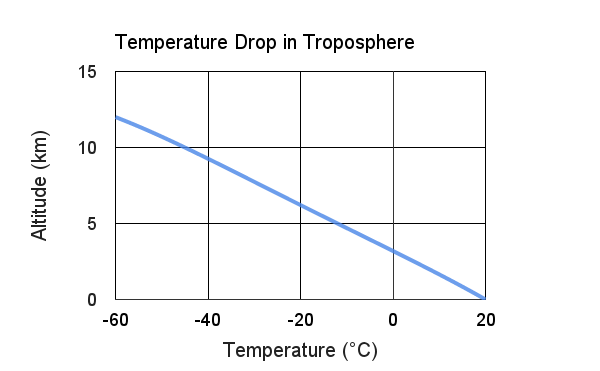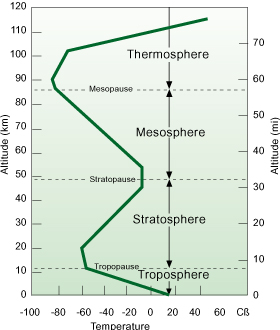Composition of the Atmosphere is roughly as follows:
- Four fifths (78%) nitrogen
- one fifth (21%) oxygen
- 1% argon
- Less than 1% of various other gases: water, carbon dioxide, neon, ammonia, helium, methane, krypton
Atmospheric Pressure is the pressure exerted by earth’s atmosphere.
- Pressure in the lower atmosphere is highest – most of the air is near the earth’s surface.
- Pressure decreases (less air) as you move up the atmosphere.
- Higher pressure means more molecules per liter of volume.
Atmospheric Temperature follows an unusual trend. In the lower parts of the atmosphere, temperature gets cooler as you move up in the atmosphere.

The bottom of the graph shows a temperature of 20°C at sea level, and as we rise to 12 km above the earth’s surface, the atmosphere’s temperature drops to -60°C.
When we rise further than 12 km above the earth, however, the trend reverses:

The atmosphere is divided into four layers. The boundaries of these layers are the places when the temperature trend reverses (dotted lines on graph).
Troposphere:
- Lowest layer
- Highest density air – gravity pulls most of the air close to the ground. 80% of that atmosphere’s mass is in the troposphere.
- Warmest layer, because it is close to the warm ground and because it has the highest concentration of greenhouses gases to hold in heat coming from the ground
- Nearly all of the atmosphere’s water is in this layer, so the troposphere has virtually all of earth’s clouds and weather.
- The top of the troposphere is a bit higher than Mount Everest and a bit higher than typical cruising altitude for commercial jets.
Stratosphere:
- This layer is much calmer than the troposphere, partly because the air is thinner, makings winds weaker.
- Contains the ozone layer; ozone absorbs ultraviolet light from the sun, which warms up the stratosphere. This is why the atmosphere starts to warm up again as you rise through the stratosphere.
- The air is too thin for normal planes and jets to fly into the stratosphere.
- The surroundings are black in the stratosphere, because the air is too thin to scatter blue light the way the lower atmosphere does. Therefore, it looks very much like you’re in space if you go to the stratosphere.
Mesosphere:
- The top of the mesosphere is the coldest place on earth (-90 °C).
- Very thin air and very cold!
Thermosphere
- The air is even thinner in the thermosphere.
- The average temperature of the molecules in the thermosphere actually increases with altitude because of the direct sunlight. However, there are so few molecules per liter that the amount of heat stored in the thermosphere is minimal. If you brought a regular thermometer to the stratosphere, it would not register the temperature because not enough molecules would hit the bulb to warm it up.
- The thermosphere is a very BIG layer of the atmosphere. It extends from about 100 km altitude to about 600 km altitude. Even though it takes up a lot of volume, there is very little air in that volume.
Exosphere
- Beyond the Thermosphere, the air gradually thins out to almost nothing.
- The exosphere’s air molecules are gravitationally bound to earth, but they are so far apart that they practically never collide with each other. Therefore, they don’t behave as a gas in the same was as the rest of the atmosphere.